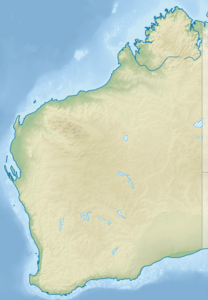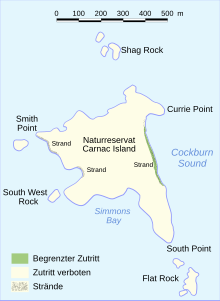Carnac Island
| Carnac Island | ||
|---|---|---|
| Carnac Island as photographed from mainland Australia | ||
| Waters | Cockburn Sound , Indian Ocean | |
| Geographical location | 32 ° 7 ′ S , 115 ° 40 ′ E | |
|
|
||
| length | approx. 800 m | |
| width | approx. 500 m | |
| surface | 0.19 km² | |
| Residents | uninhabited | |
| Detailed map of Carnac Island | ||
Carnac Island is a small, approximately 19 acre island in Cockburn Sound on the west coast of Western Australia . The uninhabited island is ten kilometers southwest of Fremantle . It is under nature protection.
Geology, flora and fauna
The island is made of limestone and is believed to have formed as a result of successive glaciations. The stone formations were also formed by wind erosion, which led to the formation of dunes in the coastal area.
The vegetation consists of low-growing, salt-tolerant plants. Since 1951 it has been scientifically examined at irregular intervals. In the course of time, there were some considerable changes. Between 1975 and 1996 there was a 37% decrease in plant species. Native species such as Acacia rostellifera and Olearia axillaris declined in favor of neophytes such as ice-herb and Malva parviflora .
The most conspicuous species of the island fauna are various sea birds as well as the Australian sea lion , the common tiger otter and the spiny-tailed skink species Egernia kingi , some of which feed on herring-headed gull eggs. Carnac Iceland is a breeding ground for fairy penguins , wedge-tailed shearwater , Elsterscharben , the Australian oystercatchers , Australseeschwalben , Caspian tern , Zügelseeschwalben , Eilseeschwalben and silver head gulls and is considered important habitat for was threatened and the protected Australian sea lions. Little is known about the invertebrates and the marine fauna.
The frequent occurrence of tiger otters, which are among the most poisonous snakes in Australia for humans, is striking. The island has the highest density of this snake species in Western Australia. The total population has been estimated at 250 to 400 adult individuals - around 20 snakes per hectare. The snakes feed on the house mice found on the island and on young brood of birds.
The origin of the tiger otters is not clear. Small differences to the tiger otters on the mainland led to the assumption that the island snakes were a backward isolated population that has lived there since the island was separated from the mainland about 5000 to 7000 years ago. Tiger otters can also be found on the neighboring Garden Island . The snakes are known to be excellent swimmers, and colonization from the neighboring island seems possible in principle. However, none of the 19th century reports mention the presence of snakes on the island and some explicitly deny it. The earliest verifiable reports of tiger otters on Carnac Island date back to 1982. Based on anecdotal accounts, today's tiger otter population is believed to be due to specimens deliberately released in 1930 by a snake trader named Rocky Vane. Vane was in regular conflict with the law and was ordered by a court to disband his snake collection after his first wife and partner died from poisonous snake bites in 1928 and 1929.
In the 19th century rabbits were released on the island in order to be able to hunt them. However, they were exterminated again in 1969. The rabbit population had a significant impact on the island's flora at the time of its existence.
history
The island was sighted on February 13, 1803 (24th Pluviôse of the year XI ) by the French navigator and explorer Louis de Freycinet and named Île Pelée ("Bald" or "Scuffed Island"). Other names in circulation were Île Levillain (after Stanislas Levillain ) and Île Berthollet (after Claude-Louis Berthollet ). In 1827, Captain James Stirling gave the island its current name after his first officer, John Carnac.
In 1836/1837 one of the first whaling stations of Western Australia was set up on Carnac Island , but abandoned after a few years. In 1884 the establishment of a quarantine station on the island for immigrants from Europe was announced. There are different statements as to whether the island was actually used for this purpose. In 1916 the island was requisitioned for defense purposes by the Australian federal government, but returned to the state of Western Australia in 1961.
natural reserve
The island has been under nature protection as a Class A reserve since 1963 . In 1972 the reserve was designated as Carnac Island Wildlife Sanctuary and in 1979 was given the status of a "Nature Reserve" ( Carnac Island Nature Reserve ). The reserve spans the island and includes the surrounding shallow waters and the Shag , Flat and South West Rocks . The island can be visited by tourists during the day, but limited to certain "zones" or the southern section of the eastern beach. The rest of the island is not allowed to be entered.
Web links
Individual evidence
- ↑ a b c d e f g h Carnac Island Nature Reserve Management Plan 2003. (pdf) Conservation Commission Western Australia, Dept. of Conservation and Land Management, 2003, accessed August 23, 2020 .
- ^ Ian Abbott, Neville Marchant, Ray Cranfield: Long-Term Change in the Floristic Composition and Vegetation Structure of Carnac Island, Western Australia . In: Journal of Biogeography . tape 27 , no. 2 , March 2000, p. 333-346 , JSTOR : 2656264 (English).
- ↑ David Pearson, Xavier Bonnet: L'île des Serpents - A twisted tale of 'tigers', Frenchmen and seagulls . In: LANDSCOPE . January 2007, p. 40-47 (English).
- ↑ a b Mitch Ladyman, Earle Seubert, Don Bradshaw: The origin of tiger snakes on Carnac Island . In: Journal of the Royal Society of Western Australia . tape 103 , 2020, p. 39–42 (English, pdf ).
- ↑ Louis Freycinet: Journal Nautique . Ed .: Archives nationales de France, série Marine, 5JJ49-50. (French, pdf ).
- ↑ Louis Freycinet: Voyage de decouvertes aux terres australes, exécuté sur les corvettes le Geographe, le Naturaliste, et la goelette le Casuarina, pendant les annees 1800, 1801, 1802, 1803 et 1804 . Paris 1815 (French, digitized from Google ).
- ^ Johann Jacob Egli: Nomina geographica: attempt at a general geographical onomatology . Verlag Friedrich Brandstetter, Leipzig 1872, p. 68 ( Google digitized version ).


